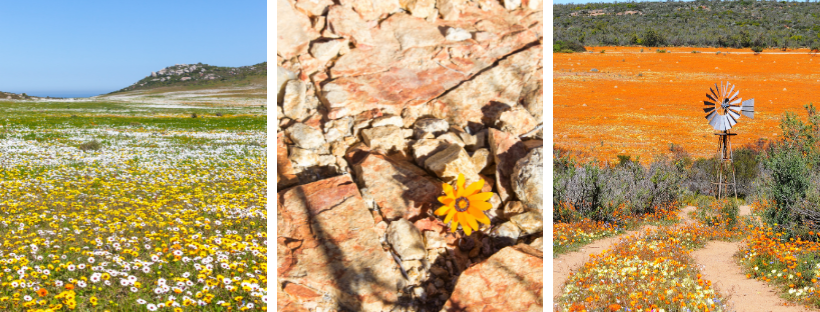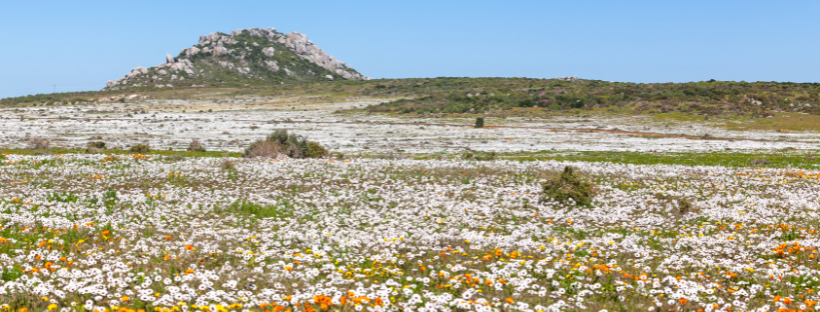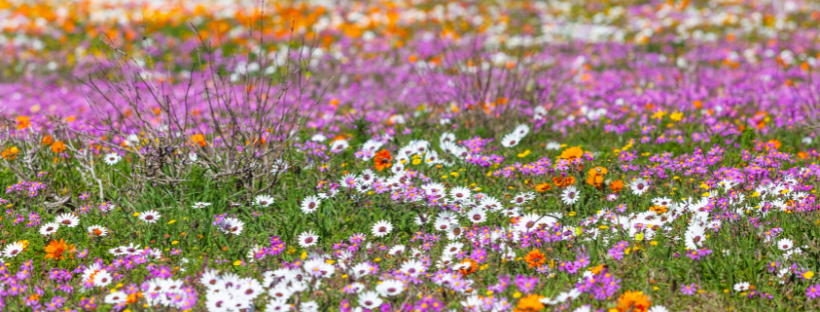From Barren To Breathtaking: The Best Places To See The Cape’s Spring Flowers
A remarkable natural spectacle unfurls across South Africa’s Western Cape and Northern Cape Namaqualand regions as winter’s grip gradually loosens and the sun’s warmth coaxes the landscape. Spring brings an explosion of vibrant colours, as the once-barren terrain transforms into a canvas of blooming wildflowers.
“On the West Coast, the flowers are appearing early this year. There’s already a fantastic display of flowers. The Postberg area is full of beautiful blooms, as are other sections of the park, like Mooimaak and the Seeberg Lookout Point,” said Pierre Nel, Senior Ranger at West Coast National Park, during our chat on 11 August. He recommends August as the prime time for those planning to visit this season. “The flowers will likely reach their peak by the first week of September and then gradually taper off,” Nel explained.
The Best Spots to Marvel at Cape’s Spring Wildflowers
The West Coast National Park becomes carpeted with white rain daisies, golden gousblom, fuchsia elandsvy and the dainty blue sporrie among other endemic species. The Postberg section of the reserve is a prime spot to witness wildflower display and is only open to visitors during August and September, while the rest of the reserve is also resplendent with flowers during this time.
The barren Namaqua National Park is known for its annual wildflower bloom which brings this landscape to life. The rainfall has been far better this year than the previous three years resulting in an excellent flower season. “Right now it’s a woman’s world in the Namaqua National Park, ” laughs Park Manager Pheladi Chuene. “I started working here in 2020 and I haven’t seen such an amazing display of flowers as we have this year. The Groenriver section is covered in flowers. Whatever colours you can think of, they’re here!”

Chuene anticipates an extended flower season this year in Namaqualand, stretching well into September due to abundant rainfall and predicted rains. She reminded visitors that you’ll need a 4×4 vehicle to visit the Groenrivier section of the park. Typically, the Skilpad section of the park is known for its vibrant carpet of flowers. “Yesterday, I took a drive and in addition to Skilpad some of the areas that were previously degraded and without vegetation are covered with flowers.”
The Cederberg’s Biedouw Valley also comes alive with spring blooms, usually around mid-August, before it’s officially spring. Following substantial winter rains (like this year’s) the typically arid agter-Pakhuis region can metamorphose into a tapestry of blossoms, abundant with yellow-and-white nemesias, blue heliophilia, mauve senecios and yellow lachenalias.
Restful Retreats Amidst the Blooms:
You can stay in Cape Town at any one of a number of gorgeous hotels, like the One & Only, Ellerman House or the Cape Grace and drive just over an hour to reach the West Coast National Park. Alternatively, unwind in an exquisite beach house like Whaler’s Way or Kalie’s Cottage in Churchhaven, overlooking the lagoon within the West Coast National Park.
Venture a bit further (about a two-and-a-half-hour drive from Cape Town) to discover Cederberg Ridge. Here, elegantly luxurious rooms adorned with earthy tones and natural textures complement the raw beauty of the surroundings. Alternatively, indulge in the plush offerings of Bushmans Kloof Wilderness Lodge, also in the Cederberg.
In the Northern Cape, Papkuilsfontein Guest Farm near Nieuwoudtville is renowned for its annual wildflower show and it offers a more private and serene experience than some of the busier tourist spots. Accommodation here is comfortable country-style and among the options is a sandstone, thatch-roofed cottage that formed part of the farm’s original homestead.
Within Namaqualand National Park, you’ll find simple yet comfortable accommodation at the Skilpad Flower Camp and the Namaqua Flower Camps. About an hour south of the park, the Agama Tented Camp blends rustic elegance and modern comfort, offering an immersive experience in Namaqualand’s natural surroundings.

While you enjoy the Western Cape and Namaqualand’s spring flower spectacle, it’s important to stay on designated paths, refrain from picking flowers, and respect local rules to protect these delicate ecosystems for generations to come. We also recommend that you consider extending your stay in each area to support sustainable tourism.
We hope that nature’s palette will help revive your soul during this springtime extravaganza!
Happy Travelling,
The Leopard Team
P.S. If you’re unable to witness the flowers this season, we’d be happy to help you plan a bespoke itinerary that includes some of South Africa’s highlights weaving in a spring flower visit for your journey.
P.P.S. Reply to this email and let us know which travel destination in Africa you’d like to know more about. We love hearing from you!
Sign up for more newsletters like this here: https://mailchi.mp/2e4afa50d15f/leopard


